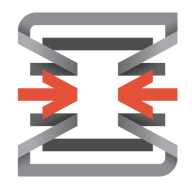


Sophos XG and OPNsense compete in the network security product category. Sophos XG appears to have the upper hand due to its comprehensive security features and ease of deployment, despite areas needing improvement.
Features: Sophos XG provides synchronized security, intrusion prevention, and integrated email protection. It also includes web and application filtering, along with sophisticated reporting tools. OPNsense, on the other hand, leverages its open-source nature to offer modular security solutions supported by plugins like Suricata for IPS/IDS and ClamAV for threat detection, allowing for flexibility with configurable components.
Room for Improvement: Sophos XG users point to the need for improved reporting, a more streamlined update process, and enhanced VPN functionalities. Better interface user-friendliness and scalability upgrades are also key areas. OPNsense could benefit from enhanced technical documentation, better integration capabilities with virtual environments, and improvements in its user portal and monitoring features.
Ease of Deployment and Customer Service: Sophos XG supports both cloud and on-premise deployments, providing versatility across different infrastructures. It has generally responsive technical support, though users feel global consistency in response times can improve. OPNsense is mostly used in on-premise settings, known for its simplicity in deployment once understood, but it lacks direct support, depending more on community and third-party assistance.
Pricing and ROI: Sophos XG offers competitive pricing with a variety of licensing options, integrating extensive features within a reasonable budget. However, the three-year licensing model and hardware renewal necessities may affect perceived ROI. OPNsense, as an open-source tool, delivers significant cost savings, notably appealing for small businesses due to low initial costs and reasonable performance, yielding high ROI for various security tasks.
Clients are now comfortable and not wasting productive hours on IT support.
The automation part is giving us a cost benefit and speed; we can react faster.
It's a very useful tool to mitigate and protect your enterprise.
The network attacks reduced by approximately 60% after using that, even without customizing the custom configuration yet.
For a very little investment, I was able to increase the security of my network.
The graphical interface of Sophos XG simplifies configurations, saving time in support and troubleshooting compared to the Linux-based solution I previously used.
We purchased endpoint security for the first time last year, and even without endpoint security, it provides comprehensive security.
It's good, but I would still say it's higher by about 10-15 percent compared to other market products with similar configurations.
They offer very accurate solutions.
The quick resolution of issues with Fortinet FortiGate is due to the support of the company and the fact that the equipment is easy to work with.
I would rate the technical support for Fortinet FortiGate a ten out of ten.
Compared to some open-source projects with weak support, OPNsense stands out for having both a strong community and commercial backing options.
I mainly rely on community support since the solution is open source.
If you say you do not have one, it is finished. This is where the monopoly starts.
They are professional, respond quickly, and help resolve issues effectively.
I rate the technical support a ten out of ten.
Their team was quick to diagnose and resolve the problem by exchanging the equipment within two weeks.
They scale up really well from smaller models like the FortiGate 40 and 50 to bigger sites with the FortiGate 100 for more throughput - up to enterprise datacenters.
The variation comes in terms of the interfaces and throughputs, but from a security perspective, you get the same benefit, irrespective of whether you have an entry-level unit or an enterprise.
We determine sizing based on multiple factors: number of users, available links, traffic types, server count, services in use, and whether services will be published.
Aside from these aspects, it demonstrated good scalability.
It supports routing, VPN setups, and traffic monitoring with additional packages like Snort and Suricata.
OPNsense is an extremely scalable solution.
You can scale up to multiple firewalls with centralized management.
You can't upgrade memory or storage on a specific model, which limits scalability.
I rate the scalability a nine out of ten.
We're experiencing 99.999% availability consistently.
I would rate the stability of Fortinet FortiGate a ten out of ten.
Currently, we are experiencing a general outage of one of the main internet service providers of the Dominican Republic, and we have not been impacted in our operations because with SD-WAN, we have another internet service provider and we are working with the second WAN connection without any disruption.
For home and small network use, OPNsense is also reliable, providing enterprise-grade security at no cost.
OPNsense is the same, but it does have a way of installing the Realtek drivers, which gives you a lot more stability overall on the system.
The only challenge faced was its inadequacy to manage large voice traffic effectively, even with dedicated hardware.
Sophos XG is very stable, even when serving as a DHCP server.
Sophos XG is resource-greedy, affecting performance even on newer computers.
It's on 24/7 and has consistently been reliable over the years.
Investing in a solution that can accommodate such growth would be more cost-effective than repeatedly purchasing new hardware.
While Fortinet claims to offer a comprehensive network solution, it falls short in addressing computer application issues, particularly server security.
When considering Sophos XG, which we also use, the logging and reporting functionality is notably more efficient.
For high availability, it's crucial to have a method in place where a designated component oversees the entire process.
Improved guidance on package usage and integration beyond relying on external tutorials or community support would be beneficial.
I would like the APIs to be more mature and more developed and have more options to automate threat hunting.
The solution should have the ability to be up to date with the most recent threats.
This suggests a vulnerability that needs addressing to ensure administrators can update patches without losing access.
Business cannot stop just because of issues with support.
Last year, I renewed the support for three years, which can sometimes be expensive but depends on the security benefits and how it helps us.
It offers cost savings as it is generally cheaper than the competition.
It is about 20% cheaper.
It is a free solution, and when you compare it to alternatives like FortiGate, which is quite powerful but also costly, the value becomes evident.
I would rate the pricing a nine out of ten, especially considering the availability of a free community edition.
It is free.
I rate the pricing a ten out of ten.
Currently, it costs about four million shillings in Kenya.
The cost depends on the package you are in, such as full threat management or basic.
In terms of security, we have not experienced any security flaws or loopholes, and it has proven to be quite stable.
FortiGate has helped reduce the risk of cyberattacks that might disrupt our client's production.
These features help reduce our downtime, manage the ISPs, and deploy SLAs for all the website traffic.
The most valuable features include the basic firewall functionality and the GeoIP location services.
I can have a Wi-Fi VLAN and feel secure that the server network or the VM network that I have on a different VLAN are isolated, and they cannot talk to one another, which adds a great level of security.
It offers enterprise-grade features such as intrusion detection and prevention system, VPN support, traffic shaping, and web filtering, all without license cost.
I particularly like the visibility it provides into network traffic, allowing us to identify and address issues efficiently.
The firewall feature of Sophos XG has been the most effective for threat prevention.
Integration with endpoint security products ensures seamless traffic flow and rule enforcement, even when endpoints are not directly connected to the firewall.
| Product | Market Share (%) |
|---|---|
| Fortinet FortiGate | 20.4% |
| OPNsense | 11.0% |
| Sophos XG | 9.6% |
| Other | 59.0% |



| Company Size | Count |
|---|---|
| Small Business | 350 |
| Midsize Enterprise | 130 |
| Large Enterprise | 187 |
| Company Size | Count |
|---|---|
| Small Business | 30 |
| Midsize Enterprise | 5 |
| Large Enterprise | 8 |
| Company Size | Count |
|---|---|
| Small Business | 140 |
| Midsize Enterprise | 50 |
| Large Enterprise | 37 |
Fortinet FortiGate excels in providing integrated VPN, firewalling, and Unified Threat Management (UTM) with centralized management and high availability. It supports remote access and comprehensive threat protection, making it a preferred choice for securing networks.
Fortinet FortiGate offers a robust security platform with features such as strong intrusion prevention, application control, and web filtering. Its integration with Active Directory and SD-WAN functionality provides scalable solutions for large networks. Users appreciate its ease of use through centralized management interfaces, ensuring robust security with flexible configurations. However, FortiGate could enhance its graphical interface and technical support responsiveness, address firmware bugs and costly licensing, improve logging, integrate better with third-party tools, and strengthen scalability and memory for log storage. Complexity in configuration and the need for intuitive features are noted challenges, and there's a demand for advanced security, zero-trust capabilities, and AI integration.
What are the key features of Fortinet FortiGate?Fortinet FortiGate is widely implemented across industries like education, finance, and government. Companies use it for firewall protection, VPN, and SD-WAN capabilities, ensuring secure perimeter and data center security. It facilitates remote access management and traffic routing optimization, offering reliable security and connectivity solutions.
OPNsense is an adaptable open-source firewall and routing platform appreciated for its flexibility, scalability, and user-friendly interface. It is equipped with robust security features and offers excellent reporting and visibility, essential for small businesses and home setups.
OPNsense stands out for its modular design, allowing cost-effective customization. This system supports VPNs and various firewall capabilities, making it suitable for securing networks from malicious traffic. Its frequent updates and extensive documentation, combined with a supportive online community, enhance user experience. However, there is room for improvement in integration with virtual servers and Azure. Scalability and hardware updates are important for large-scale environments, and users desire more reliable VPN solutions and enhanced threat intelligence tools.
What are OPNsense's most important features?OPNsense is implemented in industries requiring VPN and firewall functions, supporting site-to-site connections, protecting servers, and managing commercial network traffic. Companies apply it for security, UTM, SD-WAN, content filtering, intrusion detection, and prevention, utilizing its open-source nature and effectiveness as a next-generation firewall.
Sophos XG provides robust security capabilities, offering features like web filtering, VPN, and user-friendly management. Its intuitive setup and policy adjustments enhance security while synchronized endpoint protection ensures comprehensive defense.
Sophos XG is a network security solution with web and application filtering, VPN features, and a management interface that simplifies configuration. It offers email protection, threat prevention, and reporting capabilities, all contributing to a comprehensive defense strategy. Synchronized security with endpoints enhances protection, and advanced threat protection with efficient bandwidth management supports secure remote work environments. However, users suggest improvements in log interfaces for real-time actions and better email protection. Enhancements in link load balancing, RAM, VPN stability, and central management are needed. HTTPS filtering, certificate management, technical support, and scalability of the SD-WAN feature can see advances.
What are the key features of Sophos XG?In industries such as healthcare, education, and financial services, Sophos XG acts as a mainline defense for network security, VPN connectivity, and web filtering. It supports secure remote access, intrusion prevention, antivirus scanning, and secure web gateways integrated with endpoint systems, tailoring its extensive security capabilities to meet specific industry requirements.
We monitor all Firewalls reviews to prevent fraudulent reviews and keep review quality high. We do not post reviews by company employees or direct competitors. We validate each review for authenticity via cross-reference with LinkedIn, and personal follow-up with the reviewer when necessary.